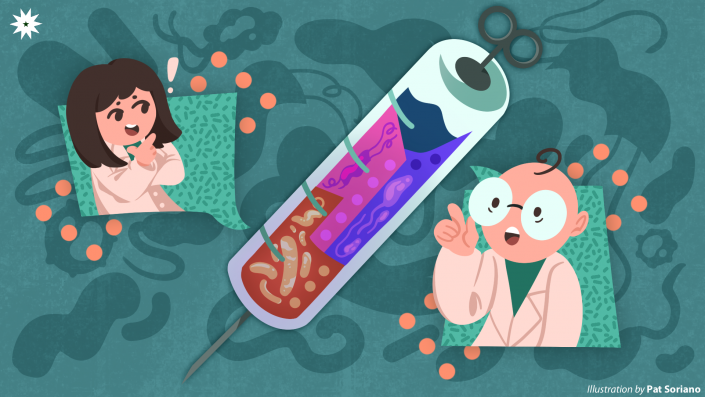There are microbes all around us—in our food, water, and even the air we breathe. Within us, too, is a complex ecosystem of microbes that help us digest our food and are essential to our health. Our relationship with them, however, does not end with cohabitation. Familiar to us in our biofuels, drugs, and even food additives, these high-value molecules are sources of our everyday essentials.

Running their own
At the heart of biotechnology lies microbial engineering—a field that involves the joint disciplines of immunology, molecular biology, and chemical engineering. Engineers may modify the genes of microbes or force them to release certain substances, with the end goal of making the microbes function in a specific manner or using them to trigger the desired response.
In pharmaceutical development, microbial engineering begins by identifying enzymes that respond to an ailment. Once identified, engineers screen microbes in search of compatible, safe, and efficient options. While several tools are involved in the process, microbes are the ones running the enginery. How they function in these drugs is innate to them; we only modify them to work in our bodies. Michael Barry, a professor at Mayo Clinic Massachusetts, describes that we are “stealing technology from evolution.”
This “stealing” may be summarized in three stages. In the first stage, the selected chemicals and enzymes are isolated from their microbial sources—common examples include bacteria, yeast, and molds. Afterward, they are purified to reduce toxicity and unnecessary functions during the second stage. Lastly, they are chemically converted to variants intelligible to our bodily systems.
These operations vary greatly depending on the type of pharmaceutical product being developed. For instance, Barry explains that a protein vaccine could be designed to use microbes to make a “protein that is structured to look like the original pathogen,” and employ that said protein to vaccinate.
Line of defense
For decades, microbial engineering researchers have come up with and have incrementally improved upon the development of vaccines in the hopes of preventing viral transmission.
Although there are various types of vaccines, they all work under the same principle. That is, once the vaccine enters your body, it would signal the immune system to produce antibodies that will eventually neutralize the pathogen before it infects other living cells.
“[The microbial vaccine] is the most potent type of vaccine,” says Barry—the same type that was used to fight off the poliovirus and the morbillivirus that causes measles. These vaccines contain dead or attenuated microbes that stimulate the body’s immune system to produce antibodies against a certain type of pathogen.
By weakening or inactivating the microbes in the vaccine, pathogens cannot cause the disease they carry with them. Instead, a pathogen profile is made for the immune system to automatically recognize when the actual attack occurs.
Building on foundations
When scientists developed the COVID-19 vaccines, Barry mentioned that certain chemicals added to the microbes—such as β-propiolactone that inactivates infectious agents by modifying the structure of its nucleic acids—only reduced the effectiveness of the vaccine. For this reason, the primary vaccines used against COVID-19 became gene-based—a newly developed type of vaccine—instead of the traditional microbial vaccine.
Unlike traditional ones, gene-based messenger RNA (mRNA) vaccines are templated from DNA. This means that a virus is not needed to make a batch of mRNA vaccines, which increases its overall effectiveness in reducing active cases of disease-causing pathogens, making mRNA vaccines one step ahead.
“You can kind of see that [in] the Pfizer vaccine [and] the Moderna vaccine,” says Barry. Both these brands developed their vaccines from a synthetic virus, which garnered an efficacy rate of 95 percent and 94 percent, respectively.
Instead of utilizing a synthetic virus, the Johnson and Johnson (J&J) vaccine was developed entirely from the adenovirus itself, with the vaccine’s efficacy rate being at least 66 percent.
Although the two types of vaccines cannot be compared because both types of vaccines tested different outcomes during the third phase of clinical tests, Pfizer and Moderna tested for symptomatic COVID-19 infections, while J&J tested whether only a single dose of its vaccine prevented moderate to severe COVID-19 symptoms. Barry adds that this is also the reason why the J&J vaccine only needs a single dose while the mRNA vaccines have to be given twice.
However, it is important to note that the efficacy rates are different from hospitalization and death prevention rates. Even with the efficacy gaps that separate the Pfizer, Moderna, and J&J vaccines, it has been reported that they all prevent death and hospitalization against COVID-19 by nearly a hundred percent.
Eliminating stigma, misinformation
The vaccines do not make you entirely immune to COVID-19; rather, it only prevents you from experiencing severe symptoms that put you and your loved ones in death-threatening situations.
However, there are still those who are skeptical about what medical practitioners administer in our bodies, especially because of the reactions some people are experiencing after being inoculated by the vaccine.
Then again, Barry reassures that side effects such as fever, chills, and body aches are normal indications that the body is building protection. He also mentions that severe side effects, such as blood clotting, seem to happen on extremely rare occasions and that the vaccine’s benefits greatly outweigh the risks.
Either way, it is certain that whatever vaccine is administered to you, the end goal is the same: training your immune system to recognize and combat the foreign objects that enter your body to prevent the transmission of viral infections for public safety and economic security.
